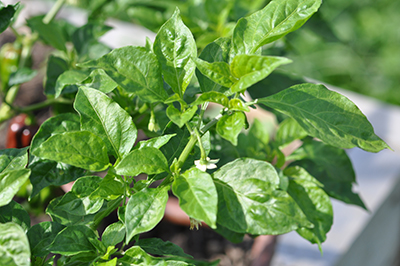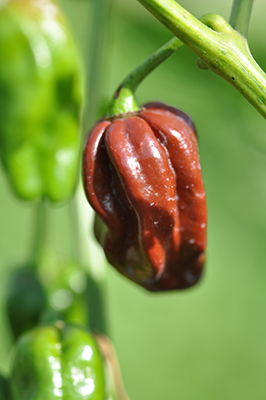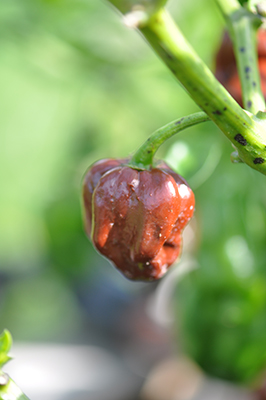Capsicum chinense L. (Solanaceae) var. Habanero Chocolate




| ENG | Habanero Chocolate |
| SK | Habanero |
| CZ | Paprička habanero |
| PL | Papryka habanero |
| HU | Habanero |
Using
Pungency reaches 150,000 to 325,000 SHU (Scoville heat units) and to ordinary foods is enough to add only a small part of the fetus. Scientific studies have shown that consumption of habanero peppers can offer a beneficial effect against prostate cancer. Habanero peppers can be effective at fighting obesity because of the presence of capsaicin. The capsaicin in habanero peppers may decrease the risk of certain diseases. Health effect of habanero peppers:
- Diabetes Prevention
- Decreased Cancer Risk
- Cardiovascular Disease Prevention
- Anti-Inflammatory Effects
| I. | II. | III. | IV. | V. | VI. | VII. | VIII. | IX. | X. | XI. | XII. | |||||||||||||
| Sowing indoors | ||||||||||||||||||||||||
| Transplant indoors | ||||||||||||||||||||||||
| Transplant in greenhouse or outdoor | ||||||||||||||||||||||||
| Harvest | ||||||||||||||||||||||||
Botanical description and occurrence:
The habanero chili comes from the Amazonas region, and from there it was spread through Mexico. Habanero chocolate peppers are extremely hot variety of chilli. It is approximately 40 x spicier than Jalapenos. Highest hotness receive fruits after 90 days of ripening on the plant. Habaneros thrive in hot weather. As with all peppers, it does well in an area with good morning sun and in soil with a pH level around 5 to 6 (slightly acidic). Ripe peppers are about two inches long and a reddish brown color
Why to have the plant in your garden:
The contrast in colour and appearance makes chili plants interesting as a garden plant. This kind of pepper can easily grow in the window and in the greenhouse. Fruits of habanero variety have a beautiful chocolate brown color. The habanero is a perennial flowering plant, meaning that with proper care and growing conditions, it can produce flowers (and thus fruit) for many years. Habanero bushes are good candidates for a container garden. Red hot peppers provide many therapeutic benefits when eaten. They are rich in vitamins A and C, contain carotene, an antioxidant, and have been shown to reduce levels of cholesterol and triglycerides in the blood. Cultures where people eat large amounts of cayenne have much lower rates of cardiovascular disease.
Text:
prof. Ing. Magdaléna Valšíková, PhD., SUA, Nitra (Slovak Republic)
Photo:
Dr. Jan Mezey, SUA, Nitra (Slovak Republic)
Links to scientific articles (if it is possible):
Michelle Kerns.2015. What Are the Benefits of Eating Habaneros?
Jan Timbrook. 2016. The Natural History of Chile Peppers. Santa Barbara Museum of Natural History.

